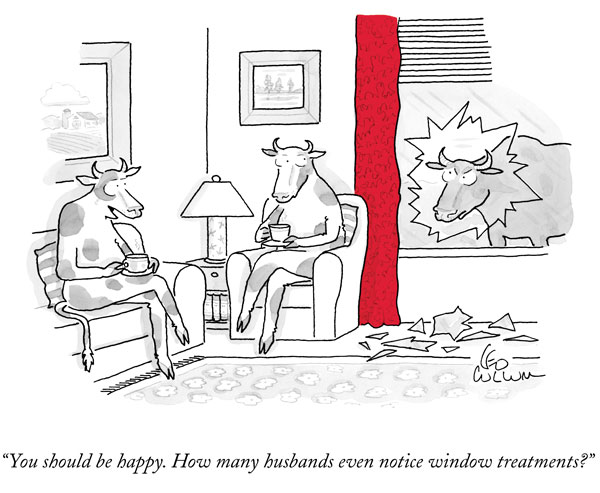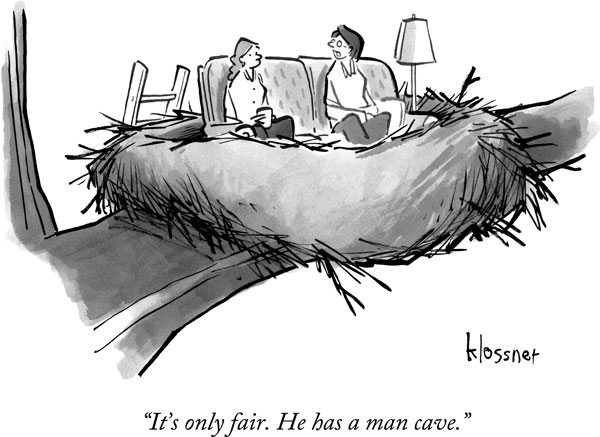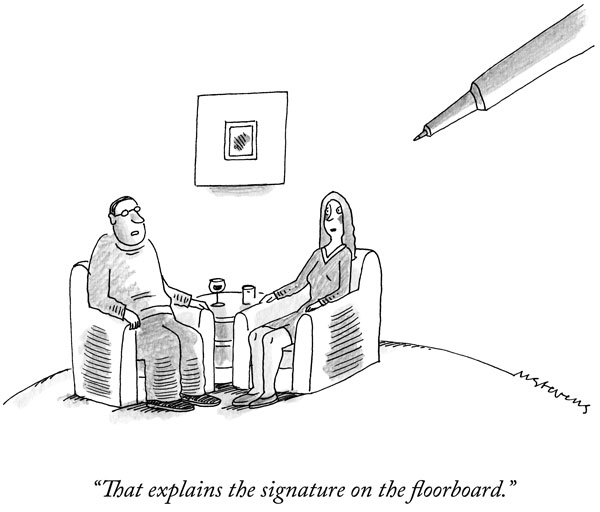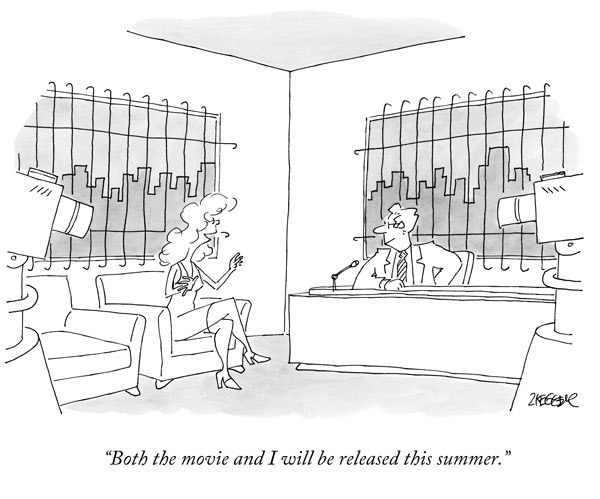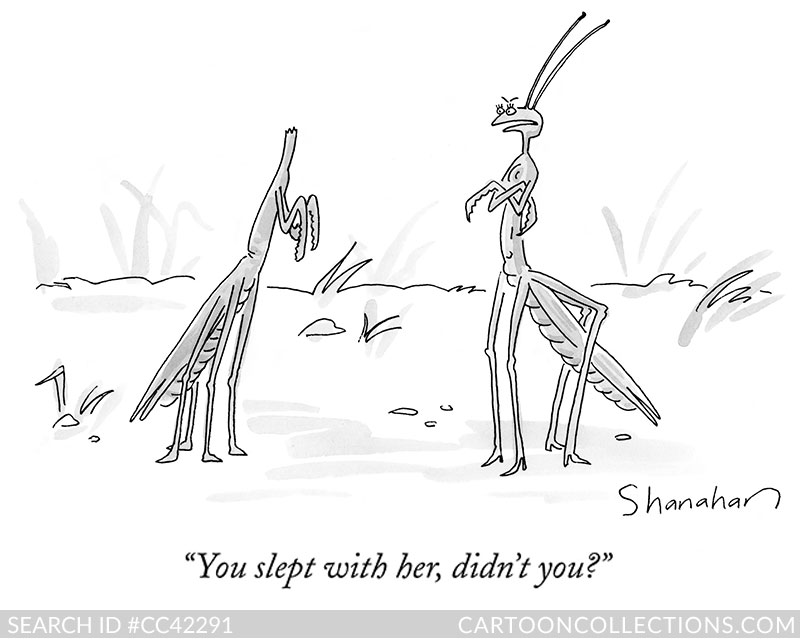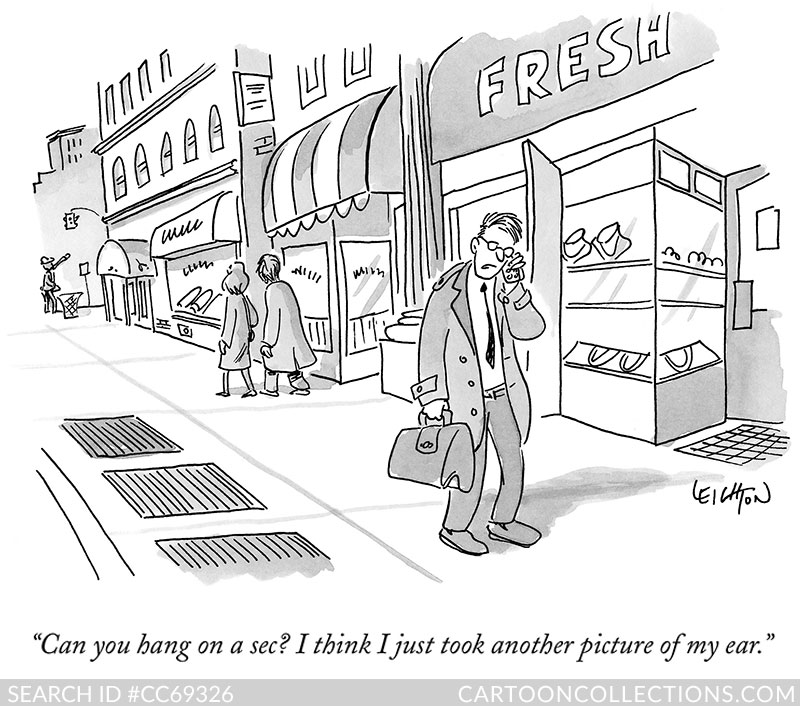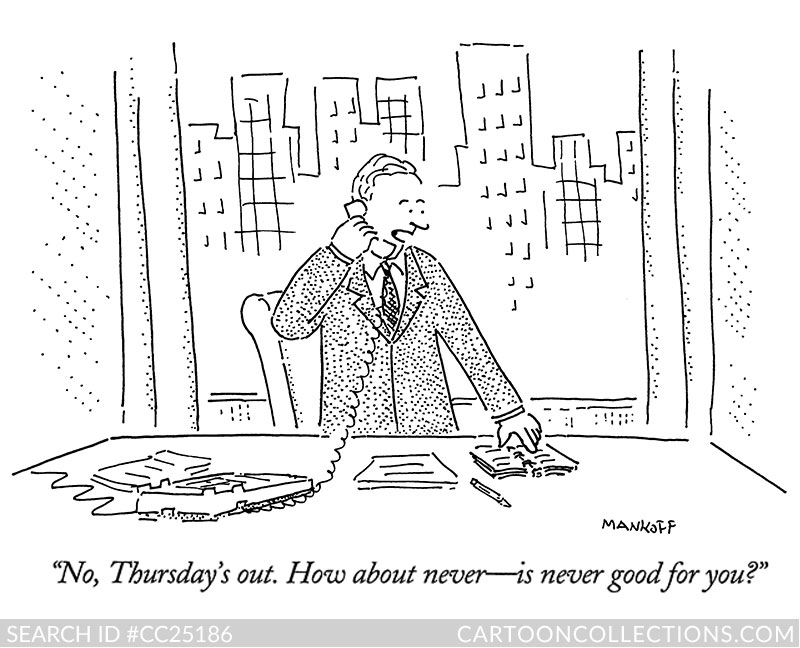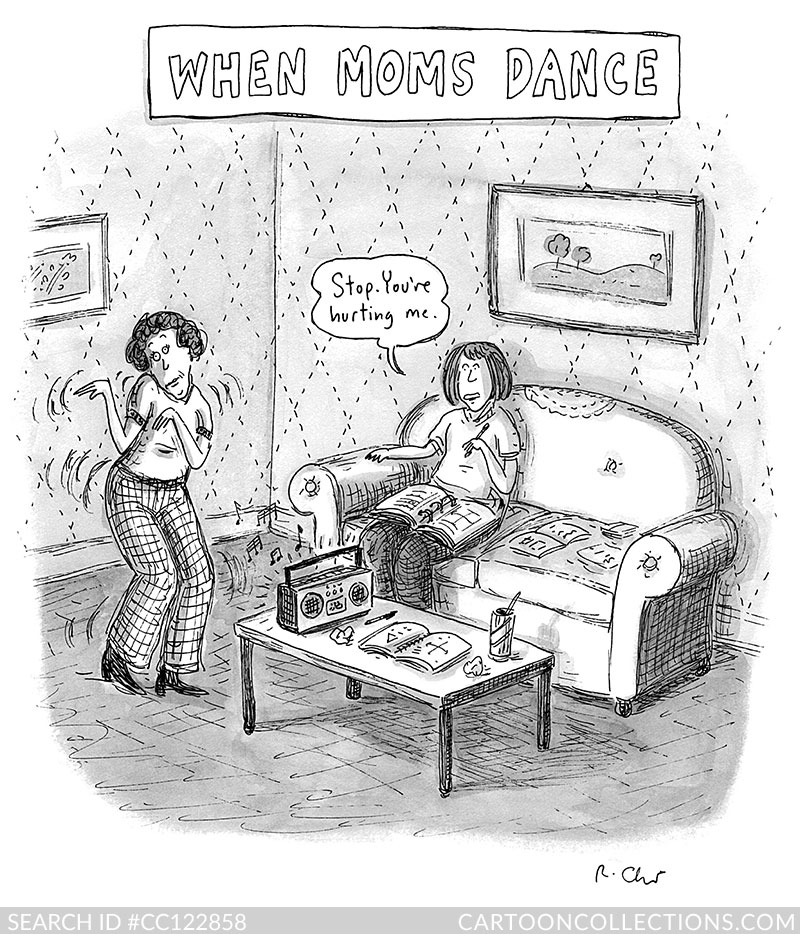 If the number of caption submissions we receive (and the number of cartoon suggestions the average cartoonist fields each week) are any indication, within the hearts of many lies a frustrated cartoonist. Let’s face it, most people think they’re pretty funny. Many are wrong.
If the number of caption submissions we receive (and the number of cartoon suggestions the average cartoonist fields each week) are any indication, within the hearts of many lies a frustrated cartoonist. Let’s face it, most people think they’re pretty funny. Many are wrong.
Humor is highly subjective; however, there is one metric which is hard to deny: winning the New Yorker Cartoon Caption contest. That indicates that at least once, you were quantifiably funny. But to win it SEVEN times? Now, that sounds like solid proof.
I had a chance to chat with Larry Wood, the seven-time New Yorker Caption Contest winner last month at the CartoonStock launch party. A tall, unimposing sort, Larry fit right in with the crew of cartoonists who’d gathered for the festivities. He’s smart, charming and quietly amusing, much like the rest of the gang.
Larry started entering captions almost immediately after Bob Mankoff began the contest in 2005, though he didn’t win until nearly two years later. His seven wins lead to collaborations with Peter Kuper and Harry Bliss on several cartoons that have been published in the magazine, and some of Bliss’s sydicated work. Lately, Larry’s been one of many sources we use to narrow down the captions we receive, as well as occasionally selecting cartoons for the contest. Seemed like a good idea to go straight to the multi-contest winner to find out his captioneering secrets.
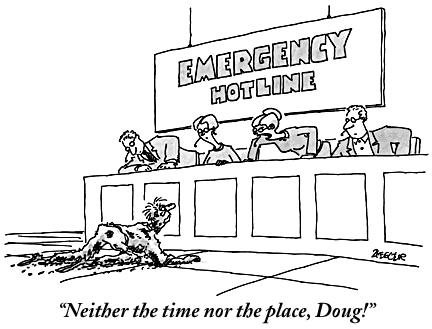 How did you become interested in the caption contest? I’ve always loved New Yorker cartoons, and I grew up reading the hard-bound collections my parents owned. I read about the caption contest soon after it was created, and I believe the first one I entered featured a Jack Ziegler drawing of a woman who’s taking calls at an emergency hotline and yelling at a man who’s been through some kind of disaster and is crawling toward her. The winning caption was, “Neither the time nor the place, Doug!” I’m not sure what I submitted, but it was something along the lines of, “No walk-ins!”
How did you become interested in the caption contest? I’ve always loved New Yorker cartoons, and I grew up reading the hard-bound collections my parents owned. I read about the caption contest soon after it was created, and I believe the first one I entered featured a Jack Ziegler drawing of a woman who’s taking calls at an emergency hotline and yelling at a man who’s been through some kind of disaster and is crawling toward her. The winning caption was, “Neither the time nor the place, Doug!” I’m not sure what I submitted, but it was something along the lines of, “No walk-ins!”
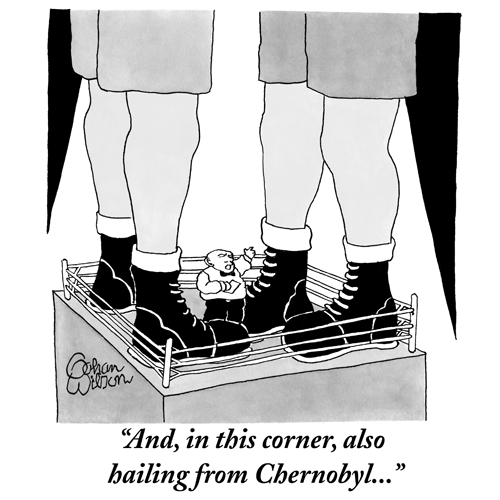 How many times have you won the New Yorker caption contest? Seven times. I was also a finalist in one contest I did not win. It featured a Gahan Wilson drawing of a referee standing between two huge boxers—you see them only from the knees down—and extending his left hand in the air and saying something. I considered two captions: “Very funny. Now give me the microphone,” and “And no fancy footwork.” I submitted the “microphone” caption and came in second behind, “And in this corner, also hailing from Chernobyl . . .” That was a just but heartbreaking result because I have long loved Wilson’s work, which I first discovered in the Playboy magazines I stole from my neighbors’ mailboxes when I was a paperboy in upstate New York in the mid-‘70s.
How many times have you won the New Yorker caption contest? Seven times. I was also a finalist in one contest I did not win. It featured a Gahan Wilson drawing of a referee standing between two huge boxers—you see them only from the knees down—and extending his left hand in the air and saying something. I considered two captions: “Very funny. Now give me the microphone,” and “And no fancy footwork.” I submitted the “microphone” caption and came in second behind, “And in this corner, also hailing from Chernobyl . . .” That was a just but heartbreaking result because I have long loved Wilson’s work, which I first discovered in the Playboy magazines I stole from my neighbors’ mailboxes when I was a paperboy in upstate New York in the mid-‘70s.
Do you submit every week? Do you still submit? Yes, and yes. Bob told me a few years ago (when he contacted me after I won my fifth contest) that he was going to have to bar me from future competitions, but he then said that he was only joking and that I could continue competing because the contests were judged “blindly” and the judges didn’t know the identity of any entrant unless and until the entrant became a finalist. (ed. note: This is also true for the contest we run at CartoonStock.)
How many captions do you typically submit per contest? For The New Yorker contest we’re only allowed to submit one (ed. note: on CartoonStock you can submit multiple entries), but I typically come up with anywhere from 3-10 and then send the captions I’m considering to a small group of friends who help me select the best one.
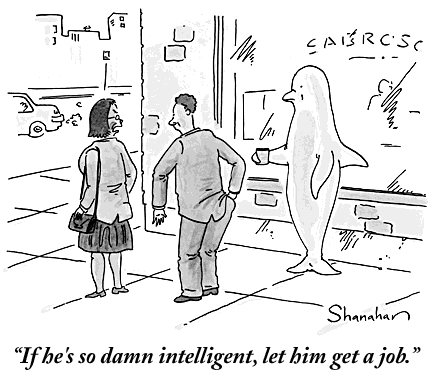
Larry’s first winner
Most cartoonists have a process for coming up with cartoons. Do you have process for coming up with a caption?
Most of the drawings used in the contest contain two frames of reference that you have to connect through the caption. For instance, the first contest I won featured a drawing by Danny Shanahan of a woman yelling at her husband, who’s reaching into his back pocket for money to give a panhandling dolphin. The caption therefore had to address both panhandling and dolphins, and the fact that the woman was angry. Dolphins are smart, and one of the cruelest things a person can say to someone who’s begging for money is “Get a job.” I tied those two ideas together by submitting, “If he’s so damn intelligent, let him get a job.” Drawings that are not so bizarre are actually harder to caption because you don’t get to work within such clearly defined parameters (as, say, coming up with a caption that addresses both panhandling and dolphins). I remember struggling to caption Drew Dernavich’s drawing of two men stuck in an endless traffic jam. The passenger’s saying something to the driver and the possibilities were endless, and that made it much harder to come up with something. I was very happy, then, when I won with, “Try honking again.”
What do you believe makes for a great New Yorker cartoon caption? This may seem obvious, but the best captions are funny. I know the general perception is that New Yorker cartoons are more clever than funny, but I completely disagree. Every week I read a few that make me laugh out loud. There are too many to name, but a few that come immediately to mind are: Danny Shanahan’s drawing of a praying mantis saying to his headless friend, “You slept with her, didn’t you?”; Robert Leighton’s drawing of a man talking on a cell phone and saying, “Can you hang on a sec? I think I just took another picture of my ear;” Roz Chast’s drawing of a teenager saying to her dancing mother, “Stop, you’re hurting me;” and, of course, “No, Thursday’s out. How about never? Is never good for you?”
You’ve seen a lot of captions while helping us narrow down our selections for voting, what are the most common mistakes people make? They’re too long, they’re too obvious, they don’t end with the punch line, they don’t recognize which character in the cartoon is speaking, and they’re just not funny.
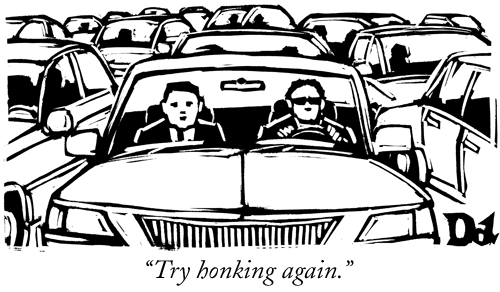
Larry’s winner from 2010
Puns. Yea or nay? Awful. Just awful. I hate puns. I have seen a few good ones, but they’ve done nothing in my mind to redeem the pun’s well-deserved reputation as the easiest and lowest form of humor.
If you could give readers three tips for coming up with a winning caption, what would they be?
1. Be brief. Although some great captions are long (see the Robert Leighton example above), brevity really is the soul of wit. Eliminate all unnecessary words.
2. End with the punch line, a closing word or phrase that surprises the reader and gives the cartoon meaning. In many unsuccessful captions, the word that should appear at the very end gets buried in the middle.
3. Be funny. I realize this is the hardest advice to follow, but it’s the most important. I’ll add this: work hard to ensure that your caption makes sense of the cartoon, either by reconciling two disparate elements (e.g., panhandling and dolphins) or by providing a backstory, and by making sure that you know which character in the cartoon is speaking and therefore delivering your line.
Here are some more of Larry’s winners:
